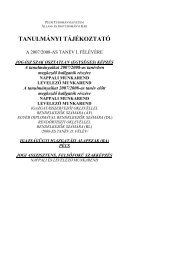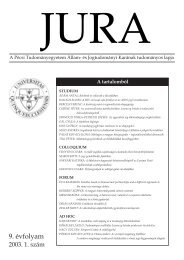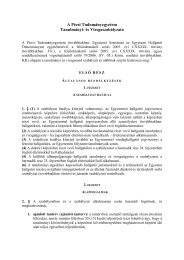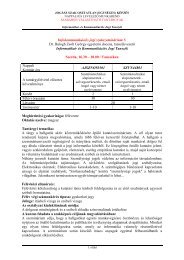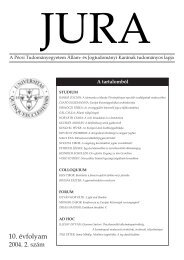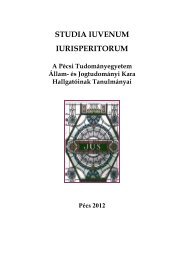2012. évi 2. szám - Jura - Pécsi Tudományegyetem
2012. évi 2. szám - Jura - Pécsi Tudományegyetem
2012. évi 2. szám - Jura - Pécsi Tudományegyetem
- TAGS
- jura
You also want an ePaper? Increase the reach of your titles
YUMPU automatically turns print PDFs into web optimized ePapers that Google loves.
178 André Ramos Tavares: The case of the borderless use of Constitutional Courts decisions in human rightscommunity courts, together with the fact that suchcourts have a vocational perspective (toward theState in question and to serve as a precedent forother states), prevents parallels being drawn for thepurposes of one sole treatment, within a unifyingtheory, of the decisions of national courts that areused by the national courts of other countries. Thedecisions handed down by national courts are appliedexclusively within their territories; they are,furthermore, directed basically toward their citizens– be they nationals or residents – and are groundedin sovereignty. In other words, they are not intendedfor the “external ambit”, nor for other contexts orrealities, as is the case necessarily with internationalcourts and, directly or indirectly, with communitycourts. The decisions of the national courts of a Statedo not need to have – and indeed do not have – anyuniversal or extra-national intentions in the sensethat such decisions are presented in terms that can beimmediately adopted by other courts in other countriesin light of their internal structures. In contrast,a multinational perspective “naturally” arises frominternational and supranational courts and from thereasons guiding such courts’ decisions, since it is theirpurpose to have a binding influence over not one, butmany countries. In some measure, these decisionshave already been structured in such a way as to beeasily repeated in many “distinct” national systemsshould the need arise.One of the most latent difficulties in this sort ofuse is precisely de-contextualization, a phenomenonthat is not seen when the subject is international orcommunity courts.<strong>2.</strong> Foreign constitutional decisionsAny reference, by a given Court, to foreign constitutionalcase law can occur in many ways and witha variety of purposes.At the center of my analysis are the non-nationalelements, with the inevitable problem of their useand the study of their respective impact upon theconstitutional decisions of a given State (in terms oflegitimacy, national sovereignty, a reduced need toreinforce arguments, honesty in the grounds of anargument etc.).However, as initially emphasized, only the foreignelements (non-national from the point of view ofthe users of such foreign elements, and national fromthe point of view of the issuing source) handed downby a single top court of the State (the ConstitutionalCourt model) or by multiple top courts (the SupremeCourt model with or without specialized sub-courts– as occurs in some countries in Latin America – andthe respective decisions thereof, and not includingthe decisions of any other courts equally authorizedto engage in constitutional debate) 8 make up theambit of this study.Indeed, I shall only analyze the use of this restricteduniverse of non-national decisions by themany top courts or by the monopolistic ConstitutionalCourt of the “receiving” 9 country. However,any discussion (not included herein) concerning theuse of these non-national elements by the differentcourts of the Judiciary of a State would, nevertheless,follow, in general terms, the models presented below,especially when a diffuse Constitutional court (fractionarydepartments of the common Courts doublingup as departments of the Constitutional Courts) isauthorized in the State.3. The model of interlocution asa suitable model for protectingfundamental rightsWhat I propose here is more openness to learningfrom concepts and solutions already generated byothers and for other countries’ legal regimes, especiallyas concerns the development of fundamentalrights and democracy.For this to happen, one must identify winningforeign experiences or legal engineering that affordsthe maximum protection to fundamental humanrights. I also consider relevant negative cases thathave generated repulsion, demotivation or the abandonmentof certain decisions negatively qualified bythe issuing State.In the model I propose, which I call the suitableinterlocution model, it is not enough to know thefinal solution adopted by the constitutional courts ofother countries. We need to know the concrete case,if there was one, that gave rise to the case law andneed to know, further, the reasons for this decision,the relevant elements, be they evident or hidden,regarding the context in which the decision wasadopted, the constitutional model of the countryand any influence upon the adopted solution it mayhave had and, especially, the interpretative formulaused.Accordingly, and in possession of the foreigndecision, which will never be a pure and objectiveelement, but rather a series of elements and conditionsconsidered for the purposes of adopting a givensolution that is now being re-analyzed, the Courtshould assess the compatibility of this material withthe constitutional system of the country of that Court,the importance and the exactness of the reasoningand the constitutional possibility of that same solu-JURA 2012/<strong>2.</strong>



